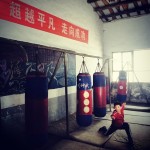I am busy transcribing interviews and translating them for a deeper post on Emei Mountain, but I thought I would lay down a few surface thoughts before they escaped into the ether, enjoy:
I went to Emei Mountain last weekend and visited with some kung fu masters there. Two to be exact. One has been a high school gym coach for the past 25 years and the other teaches wu shu performance classes to small children.
I met them at the Grand Buddha Temple, a massive, beautiful new temple built by the Emei Buddhist association to promote tourism and the Buddha. The Emei Wu Shu Alliance has a small office in the corner of the temple. Pictures of the officials responsible for the creation of the alliance line a large carpeted room where Zhang Shifu performed some tao lu for us. That was without question the first time anyone practiced any martial arts in that office.
The office director is a monk, named Chen, who I found hard to trust. He wanted me and my master, Shifu Li Cuan, to compete with Zhang Shifu on the carpet. When we refused he gave a high-pitched giggle and asked me rhetorically if I remember any of my kung fu.
All agree that the monk’s master was the last of Emei’s true martial arts masters. He studied the 12 pillars attributed to the old Emei Mountain Style and was also an ardent Buddhist. In his last years, he refused to teach anyone kung fu, proclaiming Buddhism as the true path to Zen.
The monk Chen referred repeatedly to the movie Kung Fu Panda, “inner peace” he said again and again, “kung fu’s highest attainment is inner peace … but Buddhism expressly seeks that peace through meditation. Why go through all of the combat and physical strife, when your goal can be reached as a monk?”
Chen is in charge of helping the alliance (between Emei’s Buddhists and remaining kung fu practitioners) promote Emei Style abroad. But he himself never practiced kung fu and his loyalties are with his own tribe, the Buddhist monks that were nowhere to be seen in the new temple.
***********************************
Master Zhang confided in me that the Emei style is at the brink of extinction. Only a few masters still practice anything resembling the original style, and they have no students. Many of them practice on their own and not one of them has a complete knowledge of the 12 pillars. An older temple, Hong Yan Temple, held all of the written records of the style, dating back to the Warring States period. The 12 pillars were there for all to see and many masters were available who knew some of the pillars completely. But that temple was burned down during the Cultural Revolution, along with all of the other temples in China.
When Zhang’s Master died two years ago, the last remaining link to the old lineage was broken. Zhang knows a lot, and his kung fu is both real and alive, but he knows a tiny fraction of the Emei Style. He told me that the first Dying Off happened during the rise of the Qing. Back then the authorities feared Ming rebels and counted Taoist and Buddhist martial artists as Ming sympathizers. (This was in the late 17th century). Thousands of masters were killed; dozens of styles were extinguished; hundreds of styles lost their connection to the past and to written records.
“A hundred different masters representing a hundred different styles came ot mountains like Emei and became monks,” he told me. “They then secretly taught a few students their secrets, only orally, and only at night or early in the morning.”
“That was the first great scattering of the styles.”
The scenario repeated itself 200 years later, when Red Guards persecuted and slew kung fu masters in the name of ideological purity and Mao Zedong Thought. Today, the Last Masters are in their 40s and 50s.
The Emei Wushu Alliance is run by bureaucrats and Buddhists who would use wu shu and the illusion of real kung fu to gain wealth (tourism) or power (government support for Buddhism). Just like when the original Zen masters took Bodhidarma as their patron saint, so now the Buddhists of Emei Mountain form an alliance with Emei Kung Fu. Both hope to gain from the alliance.
What I saw were two desperate masters, an opportunistic monk, some tourists, but not a single student.




Great report. Depressing stuff, but its nice to hear what is going on. I have a couple of more detailed questions for you, but I am slammed with work right now .
No worries, I am flooded with stuff as well. GOt my hands on a new book and will go to Emei again this weekend. Feel free to send your questions any time and I will try and answer them all in next week’s post. Maybe I’ll have something for tonight/tomorrow as well …
[…] Mainland China, or being replaced with performance arts and competitive boxing. We know that many styles have been lost and many masters face a future without students, but how many Shen Jianzhong’s are there in China? How many “crouching tigers” […]
What are some schools in Emei
Emei has one large school, and dozens of smaller ones scattered about. The larger school is attached to a Buddhist Monastery – slightly functional – at the base of the mountain. If you are interested, let me know some dates and I will try and get you in touch with some guys.
yes, same here in wudang. i have been researching the area since almost 4 years now here, and its depressing what has become of a holy mountain and its gongfu….
better stay and train with people from beijings parks
Hello, and sorry for the long post:
I realize this is two years after you wrote your article, but have you ever urged Zhang Shifu to work with the other practitioners to write about the old style? (Even just him is fine as I imagine of hundreds of masters he could only practice with a few.) I cannot travel to China to study what I can from the Emei Shifus as I am studying in college and not traveling abroad anytime soon, but I would love to read about the forms. history, anecdotes, and applications of forms; despite what was lost I think written records would do well to preserve an art with no students left.
I was very interested in learning about Emei and think it could have been a more appealing destination for learning about China than Shaolin had it not been for the Cultural Revolution. But I figure that should the style die, inerested folks in the future could read about and maybe revive the art.
PS does the school on Emei teach the original style to any degree? I know that Wudang and Shaolin train more for Wushu than the traditional since neither remain in their unadulterated forms there, but I hope people like Zhang give input.
Also, is there any chance that Zhang Shifu and the other Master hace been able to teach what they know of the traditional style as if late? I think we can take some comfort in Emei’s legacy if so.
I for one am very much looking forward to hearing your thoughts on that topic, as well as the related question of what sort of “Emei Kung Fu” existed to be preserved prior to 1965. I am aware of mentions of local martial arts traditions in that area going back to the Ming, but have never been able to build a really clear picture in my mind of what was going on more recently, say in the 19th century.
Thought I left a reply but I guess not.
Thats good news! I too am looking forward to hearing what has happened. Hopefully they are able to reconstruct what they remember from the pillars. It may not add up to all the pillars but it is better than losing all of it. That, and the applications of their forms as well. But I’ll take what we can get, so long as it’s genuine 🙂
Strangely, I was trying to find some info on Emei Baguazhang style and accidentally came across this post. I must say that it is disheartening to see the martial arts of Emei being now largely perished and extinct.
Those few remaining masters should pass whatever knowledge is left along to others before all is irreversibly lost.
To draw a parallel, this is something that has almost happened to a very rare and almost extinct Karate style – Kojo Ryu from Koshiro family that came from China to Okinawa in 1300’s. Of the three masters that are left, two are not teaching. The remaining one of the three is not teaching to any outsiders but to a very select few individuals.
The only way to preserve the art is to ask these masters to pass it on.
Hi
Very nice to read ypur finding. I was 20 years ago. I went to one of the martial art temple. I agreed w u, we are in rhe degeneration time.